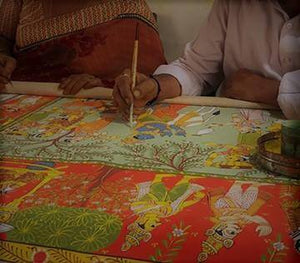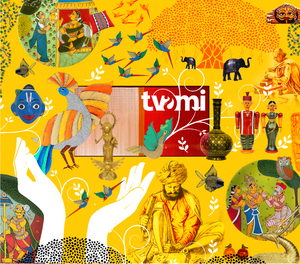
Bidri
Bidri is a unique form of metal handicraft from Bidar and is also known as Bidriware. It is known to be developed during the 14th-century C.E. Bidri craft seems to have had its origins in Persia, but with the imperial support and the expertise of the craftsmen, its later development happened in Bidar (in Karnataka).
The initial artwork during the Bahmani kingdom was a combination of Turkey and Persia. But with later stages of development, a touch of local style was given to this art form to give rise to a unique Indian craft under the rule of Second Sultan Alauddin Bahmani. The art was then passed on by the creators to the next generation, and is still practiced by local Muslim and Lingayat sects, as a preserved heritage.
Technique
Craft is all about getting the right proportions. Similarly, Bidriware is crafted by an alloy of copper and zinc, in a fixed ratio of 1:16 by casting. A mould is first formed from the soil and the addition of castor oil and resin. The zinc is what gives the craft pieces a black color. In short, the process of creating Bidri artifacts includes the steps of casting, polishing, and engraving, inlaying and then giving a black color to the last craft piece. The black color is given using a solution of copper sulphate.
The soil is said to be magical in its own ways. The artisans believe that the continuous rain for years and no sunlight is what makes this soil special, and gives the soil great oxidizing properties. The artisans in fact taste the soil by their tongues before deciding on its suitability. The knowledge of testing is obtained through experience and is passed on from generation to generation.
What makes it special?
It is unique in its own ways. The intricate inlay artwork and the metals used make this artwork as one of the most important handicraft exports. This craft is also a symbol of wealth across the world.
The list of products produced by this art has no end, starting with simple bangles, boxes and buttons to complex appealing figurines of idols, Muqabas and Surahi. Bidriware is also used in the making of hookahs, Ashtrays, paan-holders, vases, Zalabchi (Washbasin), bowls, earrings, trays, ornament boxes, and jewellery.
The future
While Bidar in Karnataka and Hyderabad in Telangana are the most famously vibrant centers, this glorious art is not restricted to these places only. Some other known centers of this craft are Purnia in Bihar, Lucknow in Uttar Pradesh, Murshidabad in West Bengal and Aurangabad in Maharashtra.
This exquisite craft is exported from India has a large market with discerning art lovers across the world. The craft products are nowadays sold at retail outlets, at Government emporia and online by different e-commerce sites.



Leave a comment